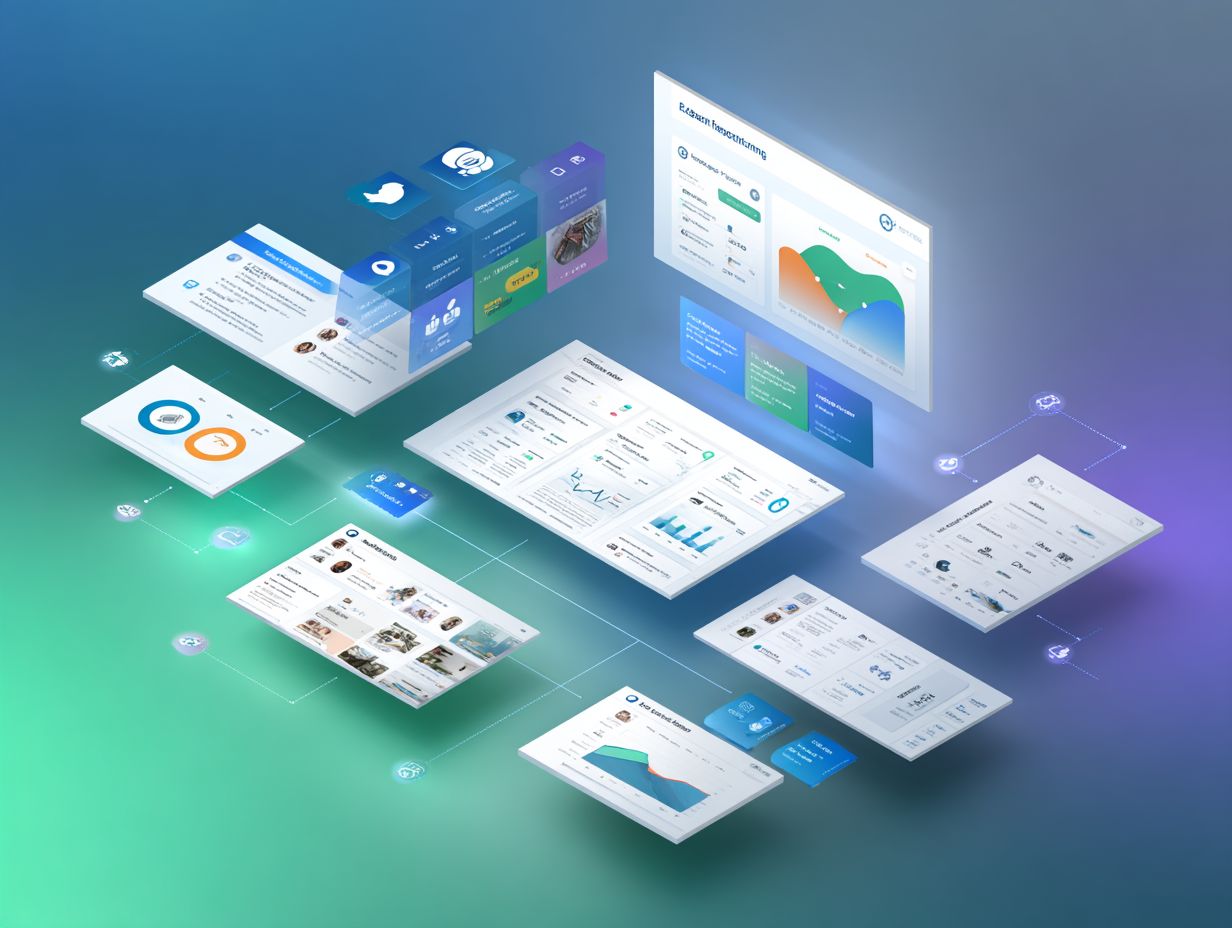CRM Integration: Strategies, Benefits, and Social Media
Connecting CRM systems is important for better managing customer relationships and increasing customer engagement. By connecting platforms like Facebook with your CRM, businesses can access useful data that helps in making strategic decisions. This article shares effective methods for successful integration, explains the advantages of using social media, and offers practical advice to improve your customer communication. Prepare to change your CRM strategy and increase interaction!
Key Takeaways:
- Combining CRM systems is important for businesses wanting to make operations more efficient and better manage customer relationships.
- Assessing business needs and selecting the right CRM system are key strategies for successful integration.
- Combining social media with CRM can give helpful information about customers and improve communication for better interaction.
- 1. Strategies for Successful CRM Integration
- Benefits of CRM Integration
- Social Media and CRM
- Challenges in CRM Integration
- Best Practices for Integration
- Frequently Asked Questions
- 1. What is CRM integration and why is it important?
- 2. What are some common strategies for CRM integration?
- 3. What are the benefits of integrating CRM with social media?
- 4. How can social media data be used in CRM integration?
- 5. What are some challenges of CRM integration with social media?
- 6. How can businesses measure the success of CRM integration with social media?
1. Strategies for Successful CRM Integration

To successfully set up a CRM system, businesses must create clear plans that match their specific goals and customer needs. Those curious about enhancing their CRM strategies might appreciate our guide on CRM integration benefits and best practices.
2. Assessing Business Needs
Before selecting a CRM, businesses must assess their specific needs, such as tracking customer interactions or managing sales pipelines.
- Start by mapping out the key customer interactions-like inquiries, purchases, and feedback.
- Next, find the necessary features that will help with these interactions, like automatic replies or connections with marketing tools.
- To quantify your requirements, set measurable goals, like enhancing customer satisfaction by 20% within six months.
- Use tools such as SurveyMonkey or Typeform to collect customer feedback to improve your criteria.
This organized method makes sure the selected CRM matches your business goals.
3. Choosing the Right CRM System
Selecting the right CRM system involves evaluating various platforms based on features, scalability, and integration capabilities.
Here’s a comparison table of five popular CRM systems to help you make an informed choice:
| System Name | Price | Key Features | Best For | Pros/Cons |
|---|---|---|---|---|
| Salesforce | $25/mo | Customizable dashboards, analytics | Large enterprises | Pros: Highly scalable; Cons: Complex for beginners |
| HubSpot | Free-$50/mo | Marketing tools, sales pipeline | Startups & SMEs | Pros: Great free tier; Cons: Limited features on free version |
| Zoho CRM | $14/mo | Email integration, reporting | Small businesses | Pros: Affordable; Cons: Steeper learning curve |
| Pipedrive | $14.90/mo | Visual sales pipeline, forecasting | Sales teams | Pros: User-friendly; Cons: Limited marketing features |
| Freshsales | $15/mo | AI-based insights, lead scoring | Tech-savvy teams | Pros: Good automation; Cons: Can be pricey as you scale |
Each system aligns differently with business sizes; for instance, Salesforce is ideal for large operations looking for deep customizations, while HubSpot’s free version benefits startups just getting started.
Benefits of CRM Integration
Connecting CRM systems can bring many benefits, such as better customer information and more efficient communication methods. For further details on these advantages, our guide on CRM Integration offers a comprehensive look at the benefits and best practices.
1. Improved Customer Insights

Bringing CRM systems into business operations helps companies understand customer choices and actions, allowing for decisions based on data.
To use this information well, companies should monitor particular measurements like customer retention rates, which show loyalty and satisfaction.
For example, Nike improved its customer retention by 5% after using CRM analytics to customize customer experiences.Sales growth percentages are an important measure; companies using CRM information to create specific marketing plans often experience an increase in earnings.
Salesforce provides detailed analytics tools that help businesses examine these metrics instantly, allowing quick changes to marketing plans and improving overall success.
2. Enhanced Communication
Connecting CRM systems improves how businesses talk to customers, leading to better engagement and increased customer satisfaction.
To do this, think about using tools like Intercom for automatic customer replies. Intercom lets you create chatbots that manage usual questions, providing quick responses even outside regular working hours.
Use one CRM system such as HubSpot to gather all customer data, allowing you to interact with customers according to their past activities.
Track engagement metrics through features in tools like Salesforce. This monitoring pinpoints what works well and what needs fixing, allowing for ongoing improvement in how we communicate with customers.
Social Media and CRM
Adding social media data to CRM systems can improve customer interaction and increase brand awareness. Implementing these insights effectively requires suitable CRM customization, which offers significant benefits as outlined in our guide on CRM Customization: Definition, Benefits, and Implementation.
1. Leveraging Social Media Data
Using social media data helps businesses learn about customer likes and market trends. To integrate social media data into CRM systems effectively, consider these actionable steps.
- First, use APIs from platforms like Facebook and Twitter to gather information about user activities and demographics. This can make your customer profiles in the CRM more detailed.
- Next, use tools like Hootsuite Insights to study user comments and identify shared topics in customer opinions and needs.
- Monitor online reviews across social platforms to gauge product feedback and make data-driven decisions.
This complete method can greatly improve your marketing plans.
2. Engagement Strategies

Creating successful ways to connect with customers can improve their loyalty and support by regularly interacting with them on different platforms.
Begin by dividing your audience into groups based on age, location, and actions to develop specific marketing strategies.
For example, use tools like Hootsuite or Sprout Social to review social media data and create custom promotions. Use social listening tools like Brandwatch or Mention to respond to customer questions and track brand opinions instantly.
Brands like Zappos excel in this area, often responding within minutes to customer queries. Build a community by using interactive content such as polls or Q&A sessions. This approach invites people to join in and strengthens customer relationships.
Challenges in CRM Integration
Although it offers benefits, setting up CRM systems presents various issues that companies need to address for a successful setup. Key challenges include data security concerns, user adoption issues, and integration with existing systems.
To deal with data security, follow GDPR rules by regularly checking your systems and using encryption software. For user adoption, develop training sessions and provide ongoing support to help employees understand the system’s benefits.
To reduce integration problems, choose a CRM solution with strong API features. For example, Salesforce connects well with many different types of business software.
Best Practices for Integration
Following recommended methods during CRM integration can improve performance and keep customer data secure. For a deeper understanding of the benefits and practices that enhance CRM integration, experts suggest reviewing CRM Integration: Definition, Benefits, and Best Practices.
To effectively implement CRM integration, follow these five best practices:
- Use Talend and similar tools for smooth data migration.
- Regularly update systems to improve security and performance;
- Bring together teams from different departments, like sales and IT, to collect complete information.
- Monitor integration performance with analytics tools like Google Analytics;
- Stay compliant with privacy regulations such as GDPR.
A well-known case is HubSpot, which combined various data sources effectively, leading to better customer interaction and more efficient workflows.
Frequently Asked Questions
1. What is CRM integration and why is it important?

CRM integration means linking a customer relationship management (CRM) system with other business tools to make data sharing easier and work processes more efficient. This is important because it provides all customer details, helping companies make smarter decisions using that information.
2. What are some common strategies for CRM integration?
Some common strategies for CRM integration include using APIs, middleware, or third-party integration platforms. Another strategy is to build custom integrations specific to your business needs. It’s important to carefully evaluate the needs and capabilities of your business before choosing a strategy.
Connecting CRM with social media helps businesses collect useful information about how their customers use social media and what they like. This information can then be used to tailor marketing strategies, increase customer interaction, and create better connections with customers.
Data from social media can be incorporated into CRM systems in different ways. It can be used to add details to customer profiles, including their interests, demographics, and preferences. It can also be used for social media listening, allowing businesses to track and respond to customer conversations on social media.
One challenge of CRM integration with social media is the large volume of data that needs to be managed and analyzed. Another challenge is ensuring data privacy and security, as social media platforms may have different data protection policies. Combining various social media platforms can be complicated and take a lot of time.
Businesses can measure the success of CRM integration with social media by tracking key metrics such as customer engagement, lead generation, and customer retention rates. They can carry out surveys or collect feedback from customers to check how happy they are with the integration and how it affects their overall experience with the business.





